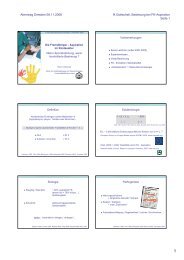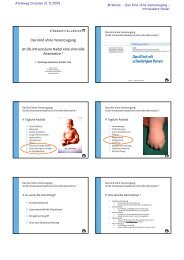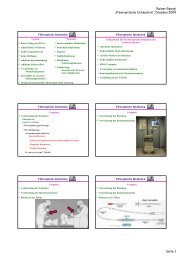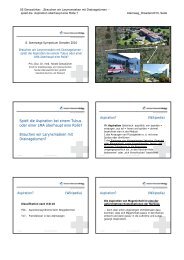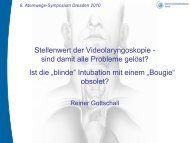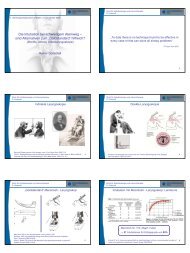Der erwartet und der unerwartet schwierige - Atemweg Uniklinikum ...
Der erwartet und der unerwartet schwierige - Atemweg Uniklinikum ...
Der erwartet und der unerwartet schwierige - Atemweg Uniklinikum ...
Sie wollen auch ein ePaper? Erhöhen Sie die Reichweite Ihrer Titel.
YUMPU macht aus Druck-PDFs automatisch weboptimierte ePaper, die Google liebt.
R. Gottschall - <strong>Der</strong> <strong>erwartet</strong> <strong>und</strong> <strong>der</strong> un<strong>erwartet</strong><br />
<strong>schwierige</strong> <strong>Atemweg</strong><br />
„Airway-Tag“ 10. April 2010<br />
KAI SRH Zentralklinikum Suhl gGmbH, ZAIN Klinikum Meiningen GmbH<br />
[1] <strong>Der</strong> <strong>erwartet</strong> <strong>schwierige</strong> <strong>Atemweg</strong> –<br />
immer fiberoptische Wachintubation?<br />
[2] <strong>Der</strong> un<strong>erwartet</strong> <strong>schwierige</strong> <strong>Atemweg</strong> –<br />
Empfehlungen <strong>und</strong> Algorithmen<br />
Reiner Gottschall<br />
„Die vorausgehende, gezielte Beurteilung des Patienten sowie<br />
eine minimale Geschicklichkeit des Anästhesisten bleiben von<br />
wichtiger Bedeutung, ebenso seine Bemühungen, die<br />
Techniken zur Anästhesie <strong>und</strong> Intubation so genau wie<br />
möglich den verän<strong>der</strong>ten anatomischen Strukturen<br />
anzupassen.“<br />
Bonfils P<br />
Die <strong>schwierige</strong> Intubation.<br />
Anästh Intensivmed 1985;26:59-64<br />
Schwierige Gesichtsmasken - Ventilation<br />
□ BMI ≥ 30 kg/m 2<br />
□ Vollbart -Träger<br />
□ Mallampati III o<strong>der</strong> IV<br />
□ Alter ≥ 57 Jahre<br />
□ Limitierte UK -Protrusion<br />
□ Schnarchen (Anamnese)<br />
□ OSAS<br />
□ Thyromentale Distanz < 6 cm<br />
Han R et al. Anesthesiology 2004;101:267<br />
Kheterpal S et al. Anesthesiology 2006;105:885-91<br />
R. Gottschall<br />
R. Gottschall<br />
„Airway management (and maintenance<br />
of oxygenation) remains the first<br />
and top priority of anesthesiologists.“<br />
WH Rosenblatt<br />
ASA Refresher Courses in Anesthesiology 2004;32:179-86<br />
Frova G, Sorbello M<br />
Minerva Anestesiol 2009;75:201-9<br />
Ursachen: angeboren o<strong>der</strong> erworben<br />
■ Fehlbildungssyndrome<br />
□ Normabweichungen<br />
■ Entzündungsfolgen<br />
■ Raumfor<strong>der</strong>ungen<br />
□ Rheumafolgen<br />
■ Operationsfolgen<br />
■ Bestrahlungsfolgen<br />
□ Hormon-, Stoffwechselstörung<br />
■ Traumafolgen<br />
□ Allergische Reaktion<br />
□ Enzymdefekte<br />
□ Fremdkörper, Stents<br />
Evaluierung des <strong>schwierige</strong>n <strong>Atemweg</strong>es (n. Benumof)<br />
1. Schneidezahn -Relation passiv (kein Überstand oben)<br />
2. Schneidezahn -Relation aktiv (UK -Mobilität vorhanden)<br />
3. Schneidezahn -Distanz (> 3 cm)*<br />
4. Oropharyngeale Relation (Mallampati ≤ II)*<br />
5. Gaumenenge, -form (weit, flach)<br />
6. Länge Submandibularraum (n. Patil ≥ 5 cm)*<br />
7. Obere Schneidezähne (kurz, fest)<br />
8. Compliance Submandibularraum (weich, dehnbar)<br />
9. Länge / Dicke des Halses (?)<br />
10. Mobilität von Kopf / Hals („Schnüffelposition“)<br />
11. Subglottischer Raum (?)<br />
Anamnese - Schnarchen / OSAS - Dysphagie - Dysarthrie -<br />
Stridor - M<strong>und</strong>atmer - Zungenmobilität - Lückengebiss -<br />
Notfallpatient - Nichtkooperative - Kanülen-, Stentträger -<br />
Bildgebung / Endoskopie - Radiatio - Vollbart -<br />
Apnoeintoleranz -…<br />
Suhl, 10.04.2010, Seite 1<br />
R. Gottschall<br />
R. Gottschall<br />
R. Gottschall<br />
1
1<br />
2<br />
3<br />
R. Gottschall - <strong>Der</strong> <strong>erwartet</strong> <strong>und</strong> <strong>der</strong> un<strong>erwartet</strong><br />
<strong>schwierige</strong> <strong>Atemweg</strong><br />
Evaluierung des <strong>schwierige</strong>n <strong>Atemweg</strong>es<br />
(Multifaktor-Risiko-Index; ab 14. Lj.)<br />
≥ 11<br />
Copyright: Dr. S. Simon, KAI FSU Jena<br />
Arnè J et al. Br J Anaesth 1998;80:140-6 R. Gottschall<br />
Welches Instrument (Erwachsene)?<br />
BD2: AD 3,7 mm; 90°<br />
Arbeitslänge 65 cm<br />
z.B. Thoraxanästhesie,<br />
Aintree ® - Katheter<br />
Vorteile (Wachintubation)<br />
□ Spontanatmung = Sicherheit<br />
□ Schutzreflexe<br />
□ Inspektion vor / nach Intubation<br />
□ Zugangswege<br />
□ Erfolgsrate↑<br />
□ Traumapotenzial↓<br />
□ Vegetative Stimulation↓<br />
□ Nutzungsdistanz, -vielfalt<br />
BN1: AD 5,2 mm; 110°<br />
Arbeitslänge 65 cm<br />
= Universalinstrument A & I<br />
4<br />
5<br />
6<br />
7<br />
R. Gottschall<br />
R. Gottschall<br />
Möglichkeit <strong>und</strong> Wirklichkeit<br />
Suhl, 10.04.2010, Seite 2<br />
Ovassapian A<br />
The flexible bronchoscope. A tool for anesthesiologists. Clin Chest Med 2003;22:281-99<br />
Airway Study and Training Center, Dept. of Anesthesia and Critical Care, University of Chicago,<br />
Chicago, Illinois<br />
□ Instrument <strong>der</strong> ersten Wahl, Kosten -sparend, atraumatisch…<br />
□ Diagnostik, Therapie, Problem -lösend…<br />
■ Methodische Möglichkeiten unzureichend genutzt…<br />
■ Tagesroutine f. Anästhesisten / Intensivmediziner gefor<strong>der</strong>t…<br />
Goldmann K, Braun U:<br />
Airway management practice at German university and university-affiliated teaching<br />
hospitals – equipment, techniques and training: results of a nationwide survey.<br />
Acta Anaesthesiol Scand 2006;50:298-305<br />
Indikationen (Wachintubation)<br />
□ Erwartet <strong>schwierige</strong>r <strong>Atemweg</strong> (strukturell, funktionell)<br />
□ Un<strong>erwartet</strong> <strong>schwierige</strong>r <strong>Atemweg</strong> (Aufwachen, Verschieben)<br />
□ Erhalt <strong>der</strong> Spontanatmung (MMS -Prävention)<br />
□ Aspirationsrisiko<br />
□ Neurologische Beurteilung<br />
□ Prävention von Intubationsschäden<br />
□ Extreme Patientenposition<br />
□ Ausbildung, Training<br />
R. Gottschall<br />
Rosenblatt WH J Clin Anesth 2004;16:312-16<br />
Langeron O et al. Critical Care 2008;10:243-7 R. Gottschall<br />
Nachteile (Wachintubation)<br />
□ Patientenkooperation erfor<strong>der</strong>lich<br />
□ Diskomfort möglich!<br />
□ Laryngeale Tubuspassage „blind“<br />
□ Zeitaufwand (Intubation, Aufbereitung)<br />
□ Komplexität, Handhabung (Lernkurve*, Assistenz)<br />
□ Methodische Grenzen (u.a. massives Gesichts-Hals-Trauma)<br />
*Wheeler M, Ovassapian A Fiberoptic endoscopy-aided techniques.<br />
In: Hagberg CA (ed) Benumof´s Airway Management, 2nd edition,<br />
Mosby Elsevier, Philadelphia 2007, p 399-438<br />
R. Gottschall<br />
2
R. Gottschall - <strong>Der</strong> <strong>erwartet</strong> <strong>und</strong> <strong>der</strong> un<strong>erwartet</strong><br />
<strong>schwierige</strong> <strong>Atemweg</strong><br />
Vorbereitung (Checkliste)<br />
□ Aufklärung <strong>und</strong> individuelle Prämedikation<br />
□ Geeignete Fiberoptik, Lichtquelle <strong>und</strong> div. Hilfsmittel<br />
□ Patientenmonitoring (EKG, NIBD, SaO 2 , ggf. EtCO 2 )<br />
□ Sauerstoffgabe<br />
□ Intravenöser Zugang, Absaugvorrichtung<br />
□ Topische Anästhesie<br />
□ Analgosedierung<br />
□ Geeigneter Tubus, Beissring<br />
□ Antibeschlag-, Gleitmittel<br />
Schleimhautanästhetika<br />
□ Lidocain 2% bis 3 - 4 mg / kg (Erwachsene)<br />
1-2% bis 4,5 mg / kg (Kin<strong>der</strong>)<br />
Xue FS et al. Anesth Analg 2009;108:536-43<br />
□ Lidocain 3% + Phenylephrin 0.25% (Erwachsene, bis 2 ml nasal)<br />
□ Alternative - Tetracain (Ester)*<br />
z.B. Acoin ® -Pumpspray vs. Lösung (COMBUSTIN)<br />
~ 0,8 mg / kg (?) Evaluierung nicht abgeschlossen<br />
(n. Dr. F. Stanzel, Hemer)*<br />
Schleimhautanästhesie mittels FFO laryngotracheal<br />
BN1 -Serie<br />
(STORZ)<br />
LA<br />
O 2 (5 L/min)<br />
□ Oxygenation<br />
□ LA -Menge↓<br />
□ Sicht↑<br />
R. Gottschall<br />
R. Gottschall<br />
R. Gottschall<br />
Supportive Pharmaka<br />
„conscious sedation“<br />
Suhl, 10.04.2010, Seite 3<br />
□ Anticholinergikum (Atropin s.c.; Glycopyrrolat i.v.) fakultativ<br />
□ Midazolam niedrigdosiert p.o. / titriert i.v.<br />
□ Remifentanil -Perfusor* (0,05 - 0,175 µg / kg / min) n. Wirkung!<br />
Bild: Mit Einverständnis des Patienten<br />
→ Klinische Zeichen: - subjektives Wärmegefühl<br />
- Spontanatmung (Af↓ EtCO 2 ↑)<br />
- Miosis / Augenlidschwere<br />
- BD / Hf ↓<br />
- Hustenreflexdämpfung<br />
Reusche & Egan J Clin Anesth 1999;11:64-8<br />
Puchner W et al. Acta Anaesthesiol Scand 2002;46:350-4<br />
Machata AM et al. Anesth Analg 2003;97:904-8<br />
Beers & Camporesi CNS Drugs 2004;18:1085-104*<br />
Mingo OH et al. Anaesthesia 2008;63:1065-9 R. Gottschall<br />
Schleimhautanästhesie naso-, oropharyngeal<br />
Mucosal Atomization Device (oral / nasal)<br />
Option: krikothyroidal<br />
www.wolfetory.com<br />
www.LMA-Deutschland.de<br />
□↑Patientenkomfort<br />
□ Optimierte Applikation<br />
□ LA - Einsparung<br />
Methodische Grenzen (Wachintubation)<br />
R. Gottschall<br />
□ Anwen<strong>der</strong>, Assistenz, Patient<br />
□ Technik, Hilfsmittel, Aufbereitung<br />
□ Topische Anästhesie, Sedierung<br />
□ Kritische Oxygenation, Zeitdruck<br />
□ Keine Glottisvisualisierung (Distorsion)<br />
□ Rigide Hin<strong>der</strong>nisse, Stenosen, etc<br />
□ Sichtverlust, Absaugkapazität<br />
→ Alternative zwingend: „Plan B“<br />
Wulf H et al. Acta Anaesthesiol Scand 1997;41:1080-2<br />
Hershey MD, Hannenberg AA Anesthesiology 1998;85:479-0<br />
Ho AMH et al. Can J Anaesth 2004;51:838-41<br />
Ho CM et al. Br J Anaesth 2005;94:856-8<br />
Kaneko Y et al. J Clin Anesth 2006;18:135-7 R. Gottschall<br />
3
R. Gottschall - <strong>Der</strong> <strong>erwartet</strong> <strong>und</strong> <strong>der</strong> un<strong>erwartet</strong><br />
<strong>schwierige</strong> <strong>Atemweg</strong><br />
♀ 50J. Struma multinodosa mit retrosternalem Anteil Alternativen zur fiberoptischen Wachintubation<br />
Proze<strong>der</strong>e: OK erhöht, O2-Brille, topische LA Zunge/Rachen →<br />
3 ml Lidocain 4%; nasopharyngeal re.1 ml Lidocain<br />
3% + Phenylephrin 0,25%, UItiva ® -Perfusor…<br />
Inspektion FFO 3,7 mm oral / nasopharyngeal re.,<br />
Glottisebene erschwert auffindbar, Sekretabsaugung<br />
pharyngeal mittels Absaugkatheter<br />
Larynx n. ventral gekippt?, <strong>Atemweg</strong> dorsolateral re.<br />
verlagert, schließlich 2 ml Lidocain 4% tracheal<br />
FFO 5,2 mm + Rüschflex 7,0 mm ID, manuelle<br />
Zungenfixation nach außen → Intubation orotracheal<br />
Extubation über TWK „Endo Guide“, Intoleranz,<br />
Entfernung, Atmung frei, keine Recurrens -Parese<br />
Alternativen zur fiberoptischen Wachintubation<br />
□ LA / Regionalanästhesie (Plan B erfor<strong>der</strong>lich!)<br />
Soens MA et al. Obstetric anaesthesia for the obese and morbidly obese patient: an ounce of<br />
prevention is worth more than a po<strong>und</strong> of treatment. Acta Anaesthesiol Scand 2008;52:6-19<br />
□ Selektive chirurgische Koniotomie / Tracheotomie in LA<br />
Schuss U u. Mitarb. Die selektive Koniotomie (unveröffentlicht)<br />
Altman KW et al. Urgent surgical airway interventions:…Laryngoscope 2005;115:2101-4<br />
□ Wachintubation mit alternativen Instrumenten<br />
Abramson SI et al. Awake insertion of the Bonfils retromolar intubation fiberscope in five patients<br />
with anticipated difficult airways. Anesth Analg 2008;106:1215-7<br />
□ Konventionelle Intubation in Narkose / Spontanatmung<br />
R. Gottschall<br />
Cros AM et al. Anesthesia induction with sevoflurane in adult patients with pedictive signs of difficult<br />
intubation. Ann Fr Anesth Reanim 2002;21:249-55<br />
Caponas G Intubating laryngeal mask airway. Anaesth Intensive Care 2002;30:551-69<br />
Extubation (nach <strong>schwierige</strong>r Intubation)<br />
□ Geplant - Erfüllung funktioneller / an<strong>der</strong>er Kriterien?<br />
- Präoxygenation / Absaugung / Cuff entblocken<br />
- Tubuswechsler / Aintree -Katheter (+FFO)<br />
- FFO<br />
- LMA / LT<br />
- GM / CPAP, BIPAP (NIV)<br />
- Katheter -Koniotomie / Tracheotomie (temporär)<br />
□ Ungeplant - Algorithmus für <strong>schwierige</strong>n <strong>Atemweg</strong>!<br />
R. Gottschall<br />
Hagberg & Regan In: Handbook of Difficult Airway Management. Ed. Hagberg CA, Churchill<br />
Livingstone 2000, p 373-87<br />
Kienzle F In: Airway-Management. Hrsg. Krier & Georgi, Thieme 2001, S. 272-8<br />
de la Linde Valverde CM Rev Esp Anestesiol Reanim 2005;52:557-70<br />
Karmarkar S, Varshney S Tracheal extubation. Cont Educ Anaesth Crit Care & Pain<br />
2008;8:214-0 R. Gottschall<br />
□ Fiberoptische Intubation in Narkose / Spontanatmung<br />
Suhl, 10.04.2010, Seite 4<br />
Bonnin M et al. Comparison of propofol target-controlled infusion and inhalational sevoflurane for<br />
fibreoptic intubation <strong>und</strong>er spontaneous ventilation. Acta Anaesthesiol Scand 2007;51:54-9<br />
□ Fiberoptische Intubation in Narkose nach Katheterkoniotomie<br />
Gerig HJ et al. Prophylactic percutaneous transtracheal catheterisation in the management of<br />
patients with anticipated difficult airways: a case series. Anaesthesia 2005;60:801-5<br />
□ Fiberoptische Intubation über Larynxmasken<br />
Koerner IP, Brambrink AM Fiberoptic techniques. Best Pract Res Clin Anaesthesiol 2005;19:611-21<br />
Zura A et al. Use of the Aintree intubation catheter in a patient with an unexpected difficult airway.<br />
Can J Anaesth 2005;52:646-9<br />
Fiberoptische Intubation (Allgemeinanästhesie)<br />
□ Sicherung <strong>der</strong> Oxygenation / Ventilation<br />
□ Erleichterter <strong>Atemweg</strong>szugang<br />
□ Sek<strong>und</strong>äre Intubation unter Sicht<br />
Instabile / dysfunktionelle HWS (z.B. Trauma)<br />
□ Manuelle in - line Stabilisierung AA / Rel.→ DL*<br />
□ Alternative Laryngoskope / Optiken<br />
□ Fiberoptische Wachintubation<br />
□ Larynxmaske (Fastrach, Classic, ProSeal)<br />
□ Elektive Tracheotomie (LA)<br />
HWS Immobilisierung wesentlicher als Intubationstechnik.<br />
Keine Einzeltechnik ist überlegen bzw. unproblematisch<br />
Ghafoor AU et al. J Clin Anesth 2005;17:640-49<br />
Manninen PJ et al. J Neurosurg Anesthesiol 2007;19:190-4<br />
Langford & Leslie J Clin Neuroscience 2009;16:366-72<br />
* Santoni BG et al. Anesthesiology 2008;109:24-31<br />
R. Gottschall<br />
R. Gottschall<br />
R. Gottschall<br />
4
R. Gottschall - <strong>Der</strong> <strong>erwartet</strong> <strong>und</strong> <strong>der</strong> un<strong>erwartet</strong><br />
<strong>schwierige</strong> <strong>Atemweg</strong><br />
[1] <strong>Der</strong> <strong>erwartet</strong> <strong>schwierige</strong> <strong>Atemweg</strong> –<br />
immer fiberoptische Wachintubation?<br />
Wenn indiziert / machbar → ja!<br />
Ansonsten nein, nein weil es Alternativen gibt!<br />
Die RSI -Kontroverse: Krikoiddruck n. Sellick<br />
□ Keine Evidenz<br />
□ Postulat wurde wi<strong>der</strong>legt<br />
□ Kontraindikationen <strong>und</strong> potenzielle Komplikationen<br />
□ Bei Kin<strong>der</strong>n aus Leitlinie verbannt<br />
□ Gutachter?<br />
Steinmann D, Priebe H-J Krikoiddruck. Anaesthesist 2009;58:695-707<br />
Rice MJ et al. Cricoid pressure results in compression of the postcricoid<br />
hypopharynx: the esophageal position is irrelevant.<br />
Anesth Analg 2009;109:1546-52<br />
<strong>Atemweg</strong>ssicherung: Hintergr<strong>und</strong><br />
< 1% bis > 8.5% Häufigkeit des <strong>schwierige</strong>n <strong>Atemweg</strong>es,<br />
bei Kopf - Hals - Tumoren bis 11% !<br />
Bis ~ 30% Anästhesie - bedingter Morbidität / Mortalität<br />
Bis ~ 30% nicht sicher bestimmbar<br />
→ Erfor<strong>der</strong>nis institutioneller Konzepte<br />
(Ausbildungseinrichtung vs. Versorgungskrankenhaus)<br />
R. Gottschall<br />
R. Gottschall<br />
R. Gottschall<br />
[1] <strong>Der</strong> <strong>erwartet</strong> <strong>schwierige</strong> <strong>Atemweg</strong> –<br />
immer fiberoptische Wachintubation?<br />
[2] <strong>Der</strong> un<strong>erwartet</strong> <strong>schwierige</strong> <strong>Atemweg</strong> –<br />
Empfehlungen <strong>und</strong> Algorithmen<br />
Die Induktions -Kontroverse:<br />
Relaxation ohne vorherige Maskenventilation<br />
Pro: □ Keine Evidenz<br />
□ GMV leichter <strong>und</strong> sicherer<br />
□ Kompensation funktioneller Ventilationsprobleme*<br />
□ Bei RSI praktiziert<br />
□ Bei erschwerter GMV Folgemaßnahmen erleichtert<br />
Contra: □ Übliche Maßnahmen für AWM nicht entbehrlich!<br />
□ Vernachlässigung <strong>der</strong> <strong>Atemweg</strong>sevaluierung?<br />
□ (V)Erlernen <strong>der</strong> GMV ohne Relaxation<br />
□↓Indikationsschwelle für Sugammadex?<br />
□ Gutachter?<br />
Suhl, 10.04.2010, Seite 5<br />
Cal<strong>der</strong> I, Yentis SM Could „safe practice“ be compromising safe practice?...<br />
Anesthesia 2008;63:113-5<br />
*Abrams JT et al. Uper airway closure: a primary source of difficult ventilation with<br />
sufentanil induction of Anesthesia. Anesth Analg 1996;83:629-32<br />
Schwierige direkte Laryngoskopie:<br />
vorhersagbar?<br />
Test<br />
M<strong>und</strong>öffnung<br />
Patil<br />
Uk -Protrusion<br />
Ao -Extension<br />
Mallampati<br />
Sensitivität<br />
0.26<br />
0.65<br />
0.29<br />
?<br />
0.4-0.67<br />
Spezifität<br />
0.94<br />
0.81<br />
0.85<br />
0.52-0.84<br />
→ Inzidenz von C&L ≥ 3 10-11%<br />
Rose DK et al. Can J Anesth 1996;43:30-4<br />
Adnet F et al. Anesthesiology 2001;95:836-41<br />
Rosenblatt WH ASA Refresher Courses in Anesthesiology 2008<br />
?<br />
Canis domesticus<br />
R. Gottschall<br />
R. Gottschall<br />
5
R. Gottschall - <strong>Der</strong> <strong>erwartet</strong> <strong>und</strong> <strong>der</strong> un<strong>erwartet</strong><br />
<strong>schwierige</strong> <strong>Atemweg</strong><br />
Gravidität: FRC -20% VO2 +20% (40 40 s) 6 min<br />
Kleinkind: ↓ ↑ (20 20 s) 3,5 min<br />
FG: ↓↓ ↑↑ (10 10 s) 2 min<br />
Zan<strong>der</strong> R<br />
<strong>Der</strong> pulmonale Sauerstoff-<br />
Speicher. Physiologie <strong>und</strong><br />
klinischer Nutzen.<br />
AINS 2002;37:34-8<br />
Sirian R, Wills J<br />
Physiology of apnoea and the<br />
benefits of preoxygenation.<br />
CEACCP 2009;9:105-8<br />
Präoxygenation<br />
Laryngoskopie - Score n. Cormack & Lehane,<br />
modifiziert n. Cook<br />
[Macintosh -Spatel ± äußere Larynxmanöver]<br />
Cook TM A new practical classification of laryngeal view.<br />
Anaesthesia 2000;55:274-9<br />
R. Gottschall<br />
1 Stimmlippen komplett einsehbar<br />
2 (A / B) hintere Stimmlippenregion / Aryknorpel sichtbar<br />
3 (A / B) nur Epiglottis sichtbar - beweglich / fixiert<br />
4 Strukturen 1-3 nicht sichtbar<br />
Alternative Tubus - Einführhilfen<br />
□ Armierung des Endotrachealtubus (RSI) bzw.<br />
Seldinger -Technik (C&L 3)<br />
□ Armierung des DLT (bronchialer Schenkel)<br />
□ Positionierung von LMA -ProSeal<br />
Howath A et al. Anaesth Intensive Care 2002;30:624-7<br />
Brimacombe J et al. Anesthesiology 2004;100:25-9 Muallem<br />
MK et al Middle East J Anesthesiol 2005;18:385-9<br />
Detave M et al. Ann Fr Anesth Reanim 2008;27:154-7<br />
R. Gottschall<br />
n. ESCHMANN www.smiths-medical.com<br />
n. MUALLEM www.vbm-medical.de<br />
R. Gottschall<br />
(Prä-)Oxygenation<br />
Suhl, 10.04.2010, Seite 6<br />
□ Obligater Bestandteil des AWM! Dokumentation?!<br />
□ Ziel: Auffüllen des verfügbaren (!) pulmonalen O2-Speichers (FRC ~ 35 ml/kg KM; O2-Verbrauch ~ 3ml/kg/min)<br />
□ Monitoring = FetO2 (≥ 80% anstreben…)<br />
□ Maske dicht (Kapnogramm?); ≥ 8 l/min O2 ; Oberkörper 25-30°↑;<br />
ggf. CPAP / BIPAP / PSV sinnvoll…<br />
□ „Verlängerung“ durch ass. / kontrollierte Maskenventilation (PCV),<br />
ggf. Larynxmaske, apnoische Oxygenation o<strong>der</strong><br />
transtracheale Oxygenation<br />
Herriger A et al. Anaesthesia 2004;59.243-7<br />
Dixon BJ et al. Anesthesiology 2005;102:1110-5<br />
Gerlach K u. Mitarb. Anaesthesist 2006;41:93-118<br />
Tanoubi I et al. Can J Anesth 2009;56:449-66<br />
Konventionelle Laryngoskopie / Intubation:<br />
Optimierung<br />
□ Lagerung („Schnüffelposition“, „Rampe“)<br />
□ Präoxygenation<br />
□ Muskeltonus ↓; Antisalivation<br />
□ Maskenventilation; pharyngeale Schienung<br />
□ Lichtverhältnisse; Absaugoption<br />
□ Externe Larynxmanöver (BURP, OELM)<br />
□ Tubus -Einführhilfen<br />
□ Typ-, Größenwechsel von Spatel / Tubus<br />
□ Zweit -Intubateur (FA)<br />
R. Gottschall<br />
modif. n. Benumof JL ASA Annual Meeting Refresher Course 2000<br />
Levitan R Anesth Analg 2005;100:899-0 R. Gottschall<br />
Macht „um die Ecke schauen“ Sinn?<br />
□ Anpassung an die Anatomie (…macht immer Sinn)<br />
□ Anpassung an verän<strong>der</strong>te Anatomie ist schon <strong>schwierige</strong>r<br />
□ „Blinde“ Verfahren sollten <strong>der</strong> Vergangenheit angehören<br />
□ Optische Hilfsmittel sind medizinischer Standard<br />
□ Handhabung <strong>der</strong> flexiblen Fiberoptik ist komplex<br />
□ <strong>Der</strong> vergleichende Nutzen neuer Hilfsmittel ist zu belegen…<br />
Mihai R et al. A quantitative review and meta-analysis of performance<br />
of non-standard laryngoscopes and rigid fibreoptic intubation aids.<br />
Anaesthesia 2008;63:745-60<br />
R. Gottschall<br />
6
R. Gottschall - <strong>Der</strong> <strong>erwartet</strong> <strong>und</strong> <strong>der</strong> un<strong>erwartet</strong><br />
<strong>schwierige</strong> <strong>Atemweg</strong><br />
Retromolares Intubationsfiberskop n. Bonfils<br />
= optisches „Stilett“<br />
40°<br />
O 2<br />
www.karlstorz.de<br />
Rudolph & Schlen<strong>der</strong>: Anaesthesiol Reanimat 1996;21:127-0<br />
Rudolph C et al Minerva Anestesiol 2007;73:567-74<br />
Mihai R et al. Anaesthesia 2008;63:745-0<br />
Video - Laryngoskopie<br />
Kaplan MB et al. Comparison of direct and video-assisted views of the larynx during routine<br />
intubation. J Clin Anesth 2006;18:357-62<br />
Dörges V, Serocki G Blick um die Ecke. Notfall- <strong>und</strong> Intensivmedizin 2009;5:24-6<br />
Airtraq ® : Optisches Einweg - Laryngoskop<br />
R. Gottschall<br />
□ Blickwinkel ca 15° 15 → 60° 60<br />
□ + Zoom -Effekt<br />
□ Direkte + indirekte Sicht<br />
□ Kombination (Einführhilfen; FFO)<br />
□ DLT -Intubation<br />
□ Teaching optimiert<br />
R. Gottschall<br />
R. Gottschall<br />
Starre indirekte (Video-)Laryngoskope<br />
www.surgcomp.com<br />
www.airtraq.com<br />
www.b-<strong>und</strong>-p.com<br />
Kaplan MB et al. Seeing is believing: the importance of video laryngoscopy in teaching<br />
and in the managing the difficult airway. Surg Endosc 2006;Suppl 2:S479-83<br />
Suhl, 10.04.2010, Seite 7<br />
www.karlstorz.de www.ifm-leiche.de www.saegeling-mt.de<br />
www.ambu.de<br />
Video - Laryngoskopie: <strong>schwierige</strong>r <strong>Atemweg</strong><br />
R. Gottschall<br />
Maharaj CH et al. Evaluation of the Airtraq ® and Macintosh laryngoscopes in patients at increased<br />
risk for difficult tracheal intubation. Anaesthesia 2008;63:182-8<br />
Stroumpoulis K et al. Videolaryngoscopy in the management of the difficult airway: a comparison<br />
with the Macintosh blade. Eur J Anaesthesiol 2009;26:218-22<br />
Jungbauer A et al. Expexted difficult tracheal intubation: a prospective comparison of direct<br />
laryngoscopy and video laryngoscopy in 200 patients. Br J Anaesth 2009;102:546-0<br />
Serocki G et al. Management of the predicted difficult airway: a comparison of conventional blade<br />
laryngoscopy with video-assisted blade laryngoscopy and the GlideScope.<br />
Eur J Anaesth 2009;26:730-5<br />
Malin E et al. Performance of the Airtraq ® laryngoscope after failed conventional tracheal<br />
intubation: a case series. Acta Anaesthesiol Scand 2009;53:858-63<br />
Asai T et al. Use of the Pentax-AWS ® in 293 patients with difficult airways.<br />
Anesthesiology 2009;110:898-904<br />
→ C&L -Score besser, weniger Kraft appliziert<br />
→ Erfolgsrate (Intubation) höher<br />
→ Zeitaufwand (Intubation) geringer<br />
→ Erfor<strong>der</strong>nis von Zusatzmanövern (z.B. BURP) geringer<br />
→ Hämodynamische Stabilität besser<br />
Airtraq ® : Optisches Einweg - Laryngoskop<br />
triple manoeuvre (down-back-up)<br />
Dhonneur G et al. Optimising tracheal intubation success rate using the Airtraq<br />
laryngoscope. Anaesthesia 2009;64:315-9<br />
R. Gottschall<br />
R. Gottschall<br />
7
R. Gottschall - <strong>Der</strong> <strong>erwartet</strong> <strong>und</strong> <strong>der</strong> un<strong>erwartet</strong><br />
<strong>schwierige</strong> <strong>Atemweg</strong><br />
Airtraq ® : Optisches Einweg - Laryngoskop<br />
□ Einweginstrument<br />
□ Einsetzbarkeit
R. Gottschall - <strong>Der</strong> <strong>erwartet</strong> <strong>und</strong> <strong>der</strong> un<strong>erwartet</strong><br />
<strong>schwierige</strong> <strong>Atemweg</strong><br />
Menschliche <strong>und</strong> an<strong>der</strong>e Fehlerquellen<br />
Bis 70% Fehler durch „menschliche Faktoren“…<br />
Fehler: „Ich tat etwas Falsches“<br />
Verstoß: „Ich wußte es, aber ich wollte es nicht tun“<br />
□ Organisationsstrukturen <strong>und</strong> Verfahren<br />
□ Training in <strong>der</strong> Routine <strong>und</strong> von Notfallsituationen<br />
□ Organisiertes Lernen<br />
□ Formen <strong>der</strong> Zwischenfallsanalyse<br />
Rall M, Dieckmann P Safety culture and crisis resource management in airway management:<br />
General principles to enhance patient safety in critical airway situations.<br />
Best Pract & Res Clin Anaesthesiol 2005;19:539-57<br />
Manser T (Hrsg.) Komplexes Handeln in <strong>der</strong> Anästhesie, Pabst Science Publishers,<br />
Lengerich 2003 R. Gottschall<br />
Komplikationen beim <strong>Atemweg</strong>smanagement<br />
□ Kardiovaskulär (Arrhythmie, Hypertonie, Myokardischämie, …)<br />
□ Respiratorisch (Hypoxie, Hyperkarbie, Laryngo,- bronchospasmus)<br />
□ ZNS (ICP↑; neuroaxiale Läsionen; Hypoxiefolge)<br />
□ Augen (IOP↑; Druckschäden)<br />
□ Kiefergelenke, HWS, atlanto -occipitaler Übergang<br />
□ Strukturelle Läsionen (Zahnschäden, Weichteiltrauma)<br />
□ Fehlintubation (ösophageal, via falsa)<br />
□ Verschiedenes (Pharmakol. NW, Latexallergie, Barotrauma)<br />
□ Schmerzen, Hospitalisierung, Kosten, soziale / berufliche Folgen…<br />
Hagberg C et al. Complications of managing the airway.<br />
Best Pract Res Clin Anaesthesiol 2005;19:641-59 R. Gottschall<br />
Anesthesiology 2003;98;1269-77<br />
Erster Algorithmus für die<br />
Bewältigung des<br />
<strong>schwierige</strong>n <strong>Atemweg</strong>es<br />
Anesthesiologie 1993;78:597-602<br />
R. Gottschall<br />
Algorithmus – Sinn o<strong>der</strong> Unsinn?<br />
□ Vorgabe zur Problemlösung<br />
□ Bestandteil von Leitlinien (= Freiwilligkeit)<br />
- Wissensvermittlung<br />
- Qualitätsverbesserung<br />
- Angemessenheit<br />
- Kosteneffizienz<br />
Suhl, 10.04.2010, Seite 9<br />
Pro: - Verhaltensregel / Trainingsoption für Notfall<br />
- Standardisierung / Handlungskorridor (für Ärzte!)<br />
- Verbesserung des Outcome / Schadensverhütung<br />
Con: - Praxisfremde „Kochbuchmedizin“ / keine Evidenz<br />
- Innovationseinschränkung / Überreglementierung<br />
- Ignoranz individueller Situationen<br />
- Ursache forensischer Konsequenzen<br />
modif. n. Georgi R, Stuttgart R. Gottschall<br />
Algorithmuskonzeption – Empfehlungen<br />
□ Handlungskorridor (für Ärzte!)<br />
□ Facharztqualität („best practice“- Prinzip)<br />
□ Präoxygenierung / Hilferuf<br />
□ Relaxation nur bei sicherer Maskenventilation (!?)<br />
□ Maximal zwei (!) Intubationsversuche<br />
□ Erhalt von Rückzugsmöglichkeiten<br />
□ Keine Wie<strong>der</strong>holung einer Technik, die versagte…<br />
□ Situative Abweichung optional möglich<br />
□ Max. 4 Entscheidungsebenen<br />
□ Klientel, Hilfsmittel, Erfahrungsstand / Logistik vor Ort<br />
modif. n. Georgi R, Stuttgart<br />
Algorithmus – „Zugang“ zum Luftweg<br />
R. Gottschall<br />
Rosenblatt WH The airway approach algorithm: A decision tree für organizing<br />
preoperative airway information. J Clin Anesth 2004;16:312-16 R. Gottschall<br />
9
Erstellt: Dr. R. Gottschall 10/2009<br />
*HNO-OP<br />
R. Gottschall - <strong>Der</strong> <strong>erwartet</strong> <strong>und</strong> <strong>der</strong> un<strong>erwartet</strong><br />
<strong>schwierige</strong> <strong>Atemweg</strong><br />
Leitlinie <strong>der</strong> DGAI 2004<br />
0 Wachzustand<br />
4 Stufen-Schema<br />
3 Endotrachealtubus<br />
2 Pharyngeales Instrument<br />
1 Gesichtsmasken-Beatmung<br />
Anästh Intensivmed 2004;45:302-6 modif. n. Georgi R, Stuttgart<br />
Algorithmus Schwieriger <strong>Atemweg</strong><br />
Evaluierung / Strategie / Vorbereitung<br />
Lagerung<br />
Präoxygenation<br />
LA / Regionalanästhesie + Plan B vs.<br />
Primäre Tracheotomie in LA vs.<br />
Wach-FOI vs. Maskeneinleitung (Sevo) vs.<br />
Alternative Ventilation / Laryngoskopie / Intubation Erschwerte<br />
GMV + Hilfsmittel<br />
+<br />
Spontanatmung ?<br />
Eingriff fortführen /<br />
verschieben ?<br />
Sek<strong>und</strong>äre Intubation<br />
(1 Versuch) vs. Aufwachen<br />
+<br />
Erwartet<br />
−<br />
−<br />
+<br />
Hilferuf !<br />
Supraglottische Luftbrücke<br />
(2 Versuche)<br />
+<br />
„Notrohr“*<br />
Sek<strong>und</strong>äre Tracheotomie<br />
Das Larynxmasken - System<br />
4 Koniotomie / Tracheotomie<br />
−<br />
−<br />
Cicv<br />
Un<strong>erwartet</strong><br />
Invasivität<br />
AA-Induktion<br />
mit Relaxation<br />
R. Gottschall<br />
Erschwerte Laryngoskopie<br />
/ Intubation (2 Versuche)<br />
Kompetenzentscheidung 2<br />
−<br />
„Cicv“<br />
Koniotomie<br />
englumig / weitlumig<br />
„The story of the laryngal mask is far from over“ Archie Brain,1991<br />
□ Wichtigste Innovation (1988)<br />
□ Bedeutung als Routineluftbrücke nimmt zu<br />
□ Gastrale Drainageoption vorteilhaft<br />
■ 1. Wahl bei can´t ventilate ± can´t intubate<br />
■ Sek<strong>und</strong>äre Intubationshilfe<br />
□ Beherrschung <strong>der</strong> Anwendung zwingend<br />
Timmermann A Mo<strong>der</strong>nes <strong>Atemweg</strong>smangement – Aktuelle Konzepte<br />
für mehr Patientensicherheit. AINS 2009;44:246-55 R. Gottschall<br />
+<br />
1<br />
3<br />
4<br />
An<strong>der</strong>e Län<strong>der</strong>, an<strong>der</strong>e Sitten?<br />
Suhl, 10.04.2010, Seite 10<br />
Frova G, Sorbello M Algorithms for difficult airway management: a review.<br />
Minerva Anestesiol 2009;75:201-9 R. Gottschall<br />
Algorithmus – Stellenwert <strong>der</strong> Larynxmaske<br />
Benumof JL Anesthesiology 1996;84:686-99 R. Gottschall<br />
www.cookmedical.com<br />
Aintree - Katheter<br />
Länge: 56 cm<br />
AD: 19F (5,75 mm)<br />
ID: 4,7 mm<br />
ETT: ≥ 6,5 mm ID<br />
FFO: ≤ 4.5 mm AD<br />
Atherton DP et al. A ventilation-exchange bougie for fibreoptic<br />
intubations with laryngeal mask airway. Anaesthesia 1996;51:123-6<br />
R. Gottschall<br />
10
R. Gottschall - <strong>Der</strong> <strong>erwartet</strong> <strong>und</strong> <strong>der</strong> un<strong>erwartet</strong><br />
<strong>schwierige</strong> <strong>Atemweg</strong><br />
Aintree - Katheter<br />
Bil<strong>der</strong>: Prof. S. Kapral, Wien Sek. Intubation nach „bridging“<br />
mit supraglottischen<br />
Luftbrücken / (ETT-Wechsel)<br />
unter fiberoptischer Sicht…<br />
Higgs A et al. Anaesthesia 2005;60:915-20<br />
Cook TM et al. Anaesthesia 2005;60:1129-36<br />
Zura A et al. Anesth Analg 2006;103:785<br />
„Can´t intubate - can´t ventilate“<br />
Gesichtsmasken - Ventilation<br />
0 ∞<br />
einfach unmöglich<br />
1. 2. 3.<br />
C&L IIIº C&L IVº<br />
Laryngoskopie → Fehlintubation<br />
modif. n. Janssens & Hartenstein Eur J Anaesthesiol 2001;18:3-12<br />
Mort TC Anesth Analg 2004;99:607-13<br />
„Funktionell“ <strong>schwierige</strong>r <strong>Atemweg</strong><br />
(kritisch Kranke, Notfallsituation)<br />
Läsion<br />
Hypoxie<br />
Tod<br />
VO 2 ↑ FRC↓ (EtO 2 ↓) V/Q -Imbalance (Shunt↑)<br />
R. Gottschall<br />
R. Gottschall<br />
□ (Prä-)Oxygenierungsprobleme = Apnoetoleranz ↓<br />
□ Individuelle Pathophysiolgie ↔ <strong>Atemweg</strong>smanagement<br />
z.B. Schock, Myokardischämie, Spinalläsion, Hirndruck, …<br />
z.B. vegetative Dysregulation, Reflexbronchospastik, Aspiration, …<br />
Horak J, Weiss S Crit Care Clin 2000;16:411-27<br />
Rosenblatt WH Crit Care Med 2004;32 (Suppl.):S186-92<br />
Blevin AE et al. Crit Care Med 2004;32:1984-5<br />
Mort TC Crit Care Med 2005;33:2672-5<br />
Sind publizierte Algorithmen noch aktuell?<br />
□ Indirekte, (Video-)Laryngoskopie, etc.<br />
□ „Blinde“ Intubation?<br />
□ Multiple Intubationsversuche?<br />
□ Hilfsmittelvielfalt<br />
□ Maskenventilation ohne Relaxation?<br />
□ Krikoiddruck?<br />
□ Verfügbarkeit evidenter Daten…?<br />
□ Vermittlung von Fertigkeiten?<br />
Suhl, 10.04.2010, Seite 11<br />
Frerk CM, Lee G Laryngoscopy: time to change our view. Anaesthesia 2009;64:351-57<br />
Greenland KB et al. Difficult airway management - a glass half empty.<br />
Anaesthesia 2009;64:1024-5 R. Gottschall<br />
Wie<strong>der</strong>holte Laryngoskopieversuche:<br />
Komplikationsrate<br />
n = 2833 (notfallmäßige Intubationen kritisch Kranker)<br />
≤ 2 Versuche > 2 Versuche<br />
Hypoxämie 11.8 %<br />
Regurgitation 1.9 %<br />
Aspiration 0.8 %<br />
Bradykardie 1.6 %<br />
Asystolie 0.7 %<br />
vs. 70 %<br />
vs. 22 %<br />
vs. 13 %<br />
vs. 21 %<br />
vs. 11 %<br />
Mort TC Emergency tracheal intubation: complications associated with repeated<br />
laryngoscopic attempts. Anesth Analg 2004:99:607-13<br />
Welche Situationen sind zu unterscheiden ?<br />
□ „Can´t ventilate – can intubate“ → 1 Intubationsversuch sinnvoll<br />
R. Gottschall<br />
□ „Can ventilate – can´t intubate“<br />
→ Kompetenzentscheidung über Priorität von Oxygenation,<br />
Rückzugsstrategie vs. sek<strong>und</strong>äre Intubation<br />
□ „Can´t intubate / can´t see anything – can´t ventilate“<br />
→ häufig Folge inadäquaten <strong>Atemweg</strong>smanagements,<br />
Notfallmaßnahmen zwingend!<br />
□ “Can’t perform cricothyrotomy<br />
Surgery (or trauma)<br />
Hematoma (or abscess)<br />
Obesity (or access problem)<br />
Radiation distortion (or deformity)<br />
Tumor<br />
R. Gottschall<br />
11
R. Gottschall - <strong>Der</strong> <strong>erwartet</strong> <strong>und</strong> <strong>der</strong> un<strong>erwartet</strong><br />
<strong>schwierige</strong> <strong>Atemweg</strong><br />
Koniotomie - Verfahren: englumig<br />
n. Ravussin n. Enk<br />
(VBM) (COOK)<br />
70º<br />
Ravussin & Freeman Can Anaesth Soc J 1985;32:60-4<br />
Enk D Anästh Intensivbeh 2002;4:5-7<br />
Scrase & Woolard Anaesthesia 2006;61:962-74<br />
□ Koniotomie (englumig)<br />
-Bei inkompletter <strong>Atemweg</strong>sobstruktion<br />
- Geringster Zeitaufwand<br />
- Geringste Invasivität<br />
- Wachapplikation in LA möglich<br />
- Diverse Sets vorhanden (z.B. COOK / VBM)<br />
- Kombination mit Intubationsverfahren<br />
- Tracheotomie im Einzelfall vermeidbar<br />
R. Gottschall<br />
=Transtracheale Oxygenation (TTO)<br />
□ Postoperativ<br />
□ Posttraumatisch<br />
□ Infektion<br />
□ Neoplasie<br />
Jacoby et al. JAMA 1956;162:625-8<br />
□ Präventiv<br />
McLellan et al. Can J Anaesth 1988;35:404-5<br />
Gerig HJ et al. Anaesthesia 2005;60:801-5<br />
Gulleth & Spiro Arch Otolaryngol Head Neck Surg 2005;131:886-90<br />
Transtracheale Oxygenation (TTO) Koniotomie - Verfahren: weitlumig<br />
Schwarzkopf u. Mitarb. Anaesthesist 2001;50:933-336<br />
Kunitz u. Mitarb. AINS 2002;37:697-700<br />
Craven & Vanner Anaesthesia 2004;59:95-599 R. Gottschall<br />
Koniotomie - Verfahren: weitlumig<br />
→ bei kompletter oberer<br />
<strong>Atemweg</strong>sobstruktion zwingend !<br />
□ Kombi -Set:<br />
Chirurgische Koniotomie + Dilatations -Koniotomie<br />
SURGICAL SELDINGER www.cookmedical.com<br />
R. Gottschall<br />
→ bei kompletter oberer<br />
<strong>Atemweg</strong>sobstruktion zwingend !<br />
□ Chirurgische Koniotomie<br />
□ Punktions -Koniotomie<br />
□ Dilatations -Koniotomie<br />
Breitmeier u. Mitarb. AINS 2004;39:94-100<br />
Melker & Gabrielli Ann Otol Rhinol Laryngol 2005;114:525-8<br />
Byhahn & Meininger AINS 2006;9:576-84<br />
Suhl, 10.04.2010, Seite 12<br />
□ „Angioödem“<br />
□ Gendefekt<br />
□ Fremdkörper<br />
□ Cicv -Szenario<br />
www.vbm-medical.de<br />
Chirurgische Koniotomie (rapid four -step cricothyrotomy)<br />
1. Tasten<br />
R. Gottschall<br />
www.cookmedical.com<br />
R. Gottschall<br />
2. Längsinzision (Haut) / Querinzision (Ligament)<br />
3. Zug + Spreizung 4. Intubation R. Gottschall<br />
12
R. Gottschall - <strong>Der</strong> <strong>erwartet</strong> <strong>und</strong> <strong>der</strong> un<strong>erwartet</strong><br />
<strong>schwierige</strong> <strong>Atemweg</strong><br />
Koniotomie - Verfahren: weitlumig<br />
→ bei kompletter oberer<br />
<strong>Atemweg</strong>sobstruktion zwingend !<br />
□ Kombi -Set:<br />
Chirurgische Koniotomie + Dilatations -Koniotomie<br />
SURGICAL SELDINGER www.cookmedical.com<br />
R. Gottschall<br />
Welches Equipment?<br />
□ Alternatives Laryngoskop / starre Fiberoptik<br />
□ Alternative Einführhilfe für ETT<br />
□ Supraglottische Luftbrücke(n)<br />
□ Flexible Fiberoptik(en)<br />
□ Aintree ® -Katheter<br />
□ Tubuswechselkatheter (Sortiment)<br />
□ Koniotomie -Sets (eng- <strong>und</strong> weitlumig)<br />
R. Gottschall<br />
„To date there is no technique fo<strong>und</strong> to be effective in every<br />
case or that can solve all airway problems“ Agrò FE, Rom 2009<br />
Airway management is context sensitive…focus from<br />
“devices and techniques” to “preservation of gas exchange”<br />
Hung O, Murphy M, Halifax 2010<br />
R. Gottschall<br />
Schwieriger <strong>Atemweg</strong> …<strong>und</strong> danach ?<br />
□ Klinische Visite(n); ggf. HNO -Konsil<br />
□ Dokumentation A -Protokoll<br />
□ Anästhesie -Ausweis (+ Kopie Krankenakte!)<br />
□ Information Patient (Folgetag!)<br />
□ Schriftlicher Sachverhalt (→ Patient)?<br />
□ Interne Aufarbeitung, ggf. externe Aufarbeitung<br />
PaSOS Website: http://www.pasos-ains.de<br />
Suhl, 10.04.2010, Seite 13<br />
Airway Management. Leitlinie <strong>der</strong> DGAI. A&I 2004;45:302-306<br />
Rall M u. Mitrarb. AINS 2008:43:628-32 R. Gottschall<br />
<strong>Atemweg</strong>smanagement - Medikolegale Aspekte<br />
Leitlinien = Orientierung, kein Standard!<br />
→ individuelle Sorgfalt wesentlicher<br />
Kuwatsch S<br />
Haftungsrechtliche Bedeutung von Leitlinien ärztlicher Fachgesellschaften<br />
Anaesthesist 2008;57:1103-4<br />
Leitlinien (ASA, DGAI) werden<br />
gutachterlich einbezogen…<br />
Breitmeier D u. Mitarb.<br />
Rechtsmedizinische Begutachtung von Behandlungsfehlervorwürfen zu<br />
Todesfällen nach <strong>schwierige</strong>r Intubation<br />
Rechtsmedizin 2005;15:363-70<br />
Schwieriger <strong>Atemweg</strong>: DRG -Abbildung?<br />
R. Gottschall<br />
Erlösrelevanz im DRG System:<br />
u.a. Hauptdiagnose, Nebendiagnose, Proceduren, Son<strong>der</strong>tatbestände<br />
Frage:<br />
Wann darf T88.4 „Misslungene o<strong>der</strong> <strong>schwierige</strong> Intubation“<br />
als Nebendiagnose kodiert werden?<br />
Antwort:<br />
1.) MDK (SEG4): nur für un<strong>erwartet</strong> akzeptiert<br />
2.) Medizincontroller (FoKA): auch für <strong>erwartet</strong> <strong>schwierige</strong> Intubation!<br />
Fachausschuss für ordnungsgemäße Kodierung <strong>und</strong> Abrechnung ist ein Ausschuss von Mitglie<strong>der</strong>n <strong>der</strong> Deutschen Gesellschaft für Medizincontrolling<br />
Voraussetzung:<br />
korrekte Dokumentation <strong>der</strong> <strong>erwartet</strong> <strong>schwierige</strong>n Intubation mittels<br />
Scoringsystem- „juristisch klagefähig“<br />
n. Krohn K, Jena R. Gottschall<br />
13
R. Gottschall - <strong>Der</strong> <strong>erwartet</strong> <strong>und</strong> <strong>der</strong> un<strong>erwartet</strong><br />
<strong>schwierige</strong> <strong>Atemweg</strong><br />
Schwieriger <strong>Atemweg</strong>: DRG -Abbildung?<br />
Erlöswirksamkeit Patienten- Bsp.<br />
HD: Neubildung unsicheren o<strong>der</strong> unbekannten Verhaltens Niere<br />
ICD: D41.0<br />
OP: Exzision von (erkranktem) Gewebe <strong>der</strong> Niere, offen chirurgisch<br />
OPS: 5-552.0<br />
DRG: L13B RG: 1,861 Erlös: 5.274,50 €<br />
+ Nebendiagnose T88.4 „Misslungene o<strong>der</strong> <strong>schwierige</strong> Intubation“<br />
DRG: L13A RG: 2,17 Erlös: 6.150,28 €<br />
n. Krohn K, Jena<br />
R. Gottschall<br />
Fazit<br />
□ Primum nihil nocere!<br />
□ Selbstschutz<br />
□ Information<br />
□ Kommunikation<br />
□ Leitlinien<br />
□ Eigenes Konzept → Akzeptanz!<br />
□ Equipment<br />
□ Training<br />
□ Assistenz<br />
□ Analyse<br />
Suhl, 10.04.2010, Seite 14<br />
R. Gottschall<br />
14




